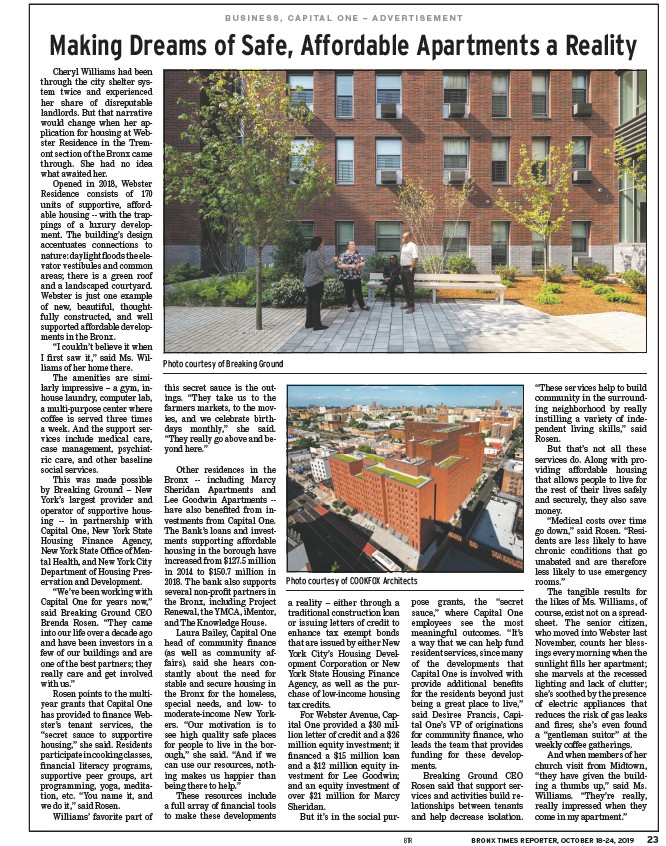
������������������������������������������������������������������������������������������������������������
BRONX TIMES REPORTER, O BTR CTOBER 18-24, 2019 23
Cheryl Williams had been
through the city shelter system
twice and experienced
her share of disreputable
landlords. But that narrative
would change when her application
for housing at Webster
Residence in the Tremont
section of the Bronx came
through. She had no idea
what awaited her.
Opened in 2018, Webster
Residence consists of 170
units of supportive, affordable
housing -- with the trappings
of a luxury development.
The building’s design
accentuates connections to
nature: daylight floods the elevator
vestibules and common
areas; there is a green roof
and a landscaped courtyard.
Webster is just one example
of new, beautiful, thoughtfully
constructed, and well
supported affordable developments
in the Bronx.
“I couldn’t believe it when
I first saw it,” said Ms. Williams
of her home there.
The amenities are similarly
impressive -- a gym, inhouse
laundry, computer lab,
a multi-purpose center where
coffee is served three times
a week. And the support services
include medical care,
case management, psychiatric
care, and other baseline
social services.
This was made possible
by Breaking Ground -- New
York’s largest provider and
operator of supportive housing
-- in partnership with
Capital One, New York State
Housing Finance Agency,
New York State Office of Mental
Health, and New York City
Department of Housing Preservation
and Development.
“We’ve been working with
Capital One for years now,”
said Breaking Ground CEO
Brenda Rosen. “They came
into our life over a decade ago
and have been investors in a
few of our buildings and are
one of the best partners; they
really care and get involved
with us.”
Rosen points to the multiyear
grants that Capital One
has provided to finance Webster’s
tenant services, the
“secret sauce to supportive
housing,” she said. Residents
participate in cooking classes,
financial literacy programs,
supportive peer groups, art
programming, yoga, meditation,
etc. “You name it, and
we do it,” said Rosen.
Williams’ favorite part of
this secret sauce is the outings.
“They take us to the
farmers markets, to the movies,
and we celebrate birthdays
monthly,” she said.
“They really go above and beyond
here.”
Other residences in the
Bronx -- including Marcy
Sheridan Apartments and
Lee Goodwin Apartments --
have also benefited from investments
from Capital One.
The Bank’s loans and investments
supporting affordable
housing in the borough have
increased from $127.5 million
in 2014 to $150.7 million in
2018. The bank also supports
several non-profit partners in
the Bronx, including Project
Renewal, the YMCA, iMentor,
and The Knowledge House.
Laura Bailey, Capital One
head of community finance
(as well as community affairs),
said she hears constantly
about the need for
stable and secure housing in
the Bronx for the homeless,
special needs, and low- to
moderate-income New Yorkers.
“Our motivation is to
see high quality safe places
for people to live in the borough,”
she said. “And if we
can use our resources, nothing
makes us happier than
being there to help.”
These resources include
a full array of financial tools
to make these developments
a reality -- either through a
traditional construction loan
or issuing letters of credit to
enhance tax exempt bonds
that are issued by either New
York City’s Housing Development
Corporation or New
York State Housing Finance
Agency, as well as the purchase
of low-income housing
tax credits.
For Webster Avenue, Capital
One provided a $30 million
letter of credit and a $26
million equity investment; it
financed a $15 million loan
and a $12 million equity investment
for Lee Goodwin;
and an equity investment of
over $21 million for Marcy
Sheridan.
But it’s in the social purpose
grants, the “secret
sauce,” where Capital One
employees see the most
meaningful outcomes. “It’s
a way that we can help fund
resident services, since many
of the developments that
Capital One is involved with
provide additional benefits
for the residents beyond just
being a great place to live,”
said Desiree Francis, Capital
One’s VP of originations
for community finance, who
leads the team that provides
funding for these developments.
Breaking Ground CEO
Rosen said that support services
and activities build relationships
between tenants
and help decrease isolation.
“These services help to build
community in the surrounding
neighborhood by really
instilling a variety of independent
living skills,” said
Rosen.
But that’s not all these
services do. Along with providing
affordable housing
that allows people to live for
the rest of their lives safely
and securely, they also save
money.
“Medical costs over time
go down,” said Rosen. “Residents
are less likely to have
chronic conditions that go
unabated and are therefore
less likely to use emergency
rooms.”
The tangible results for
the likes of Ms. Williams, of
course, exist not on a spreadsheet.
The senior citizen,
who moved into Webster last
November, counts her blessings
every morning when the
sunlight fills her apartment;
she marvels at the recessed
lighting and lack of clutter;
she’s soothed by the presence
of electric appliances that
reduces the risk of gas leaks
and fires; she’s even found
a “gentleman suitor” at the
weekly coffee gatherings.
And when members of her
church visit from Midtown,
“they have given the building
a thumbs up,” said Ms.
Williams. “They’re really,
really impressed when they
come in my apartment.”
BUS INE S S , C A PI TA L ONE – ADV ERT I S EMENT
������������������������������������������������������������������
������������������������������������������������������������������������